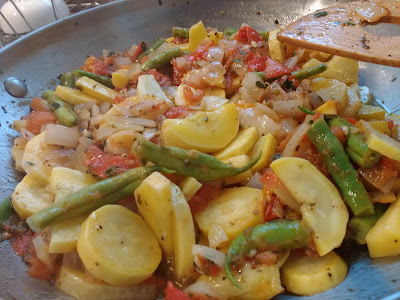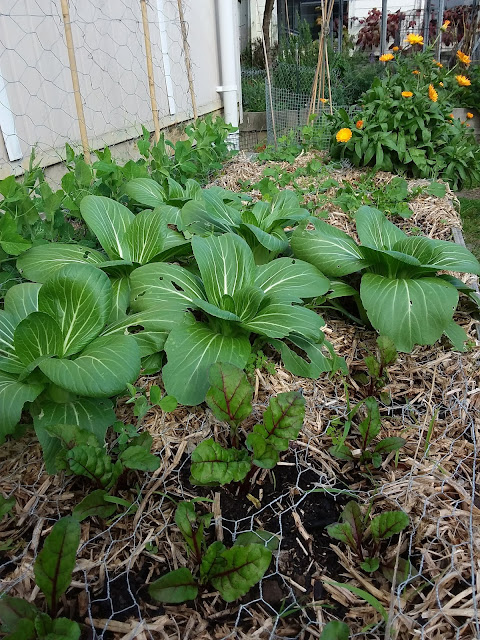What Do I Do With Them? Part 2
When I was in middle school, I spent a lot of time at my aunt's house. She would cook these amazing lunches, and it always involved delicious vegetables. They were not like what I was used to eating at my house. There was fresh beetroot, butter beans, Swiss chard, mustard and collard greens cooked in the Southern style, to name a few. It wasn't until much later that I learned that she didn't cook like that for lunch every day. She pulled out all the stops when I was visiting because she knew how much I appreciated her cooking.
The reason the vegetables were so different at her house was because my uncle had a big vegetable garden and he is a talented gardener. But the other half of the story was that my auntie was very good at knowing what to do with those vegetables! And so I am thinking of her today as I tackle the question of how to put your veggies to use in the kitchen.
Cooking from the garden isn't the same experience as cooking from the grocery store because you don't have as much control over what you've got to work with. Let's say you have a recipe that calls for a cup of spinach. But what you've got is eight cups of spinach, all ready to eat right now. Or you've got just a handful of spinach leaves, but also a small amount of five other leafy greens. You need versatile recipes. I'm going to tell you about some of my go-to recipes that aren't really recipes. So flexible that they are more like methods, really.
I break these into three main categories: raw, sauté, or roast.
Raw, Summer Version:
Salads: One of the most forgiving of non-recipes. And in case no one has told you, green salads do not have to involve lettuce, or any leafy greens at all, for that matter.Possible garden vegetables: Lettuce, spinach, young silverbeet or other leafy greens, tomatoes, cucumbers, garden peas, snow peas, sweet corn, capsicum, parsley, basil, cilantro, mint, carrot (thinly sliced or grated).
Method: Slice them all any way you like. You can add some additional goodies,such as: feta cheese, chopped nuts, olives, etc. Toss with your favourite salad dressing, or with just some olive oil, vinegar, salt and pepper.
 |
| A salad of: cucumber, cherry tomato, feta, parsley, and chives |
Raw, Winter Version:
This one is based on a combination of cole slaw, kale salad, and carrot salad recipes. A versatile Winter salad that keeps well in the fridge. The trick is mainly to chop everything up to roughly the same size.
Possible garden vegetables: Cabbage, kale, cavolo nero, silverbeet, spinach, rocket, sorrel, miner's lettuce (any leafy veggie that's good raw), parsley, mint, cilantro, carrot, beetroot.
Method: De-stem any leafy greens with a thick or tough stem (kale, silverbeet, etc.). Finely chop all leafy veggies and herbs. Grate carrot and beetroot, if using. Toss with your choice of dressing. It's good with anything you would use to dress a cole slaw, kale salad, or carrot salad.
Note: Eat this on its own or use it as a base for a more fancy salad. Or stick it into a wrap or sandwich.
 |
| Cavolo nero salad with a creamy, lemony dressing |
Sauté, Summer Version
An extremely versatile preparation for any number of tender Summer veggies.
Possible Garden Veggies: Tomatoes, courgette, eggplant, snow peas, sugar snap peas, green beans, capsicum, garlic, onion. If you have some mushrooms lying around they will be good in here too.
Method: Put a large pan on medium heat and add a generous amount of cooking oil. Add veggies according to how long they take to cook. This may take a little trial and error to get it the way you like. I like courgette and eggplant very soft so they go in at the beginning. I like my garlic just barely cooked through, so it goes in near the end. If using tomatoes, I add them near the end but give them time to fall apart a little and add their tomato-y goodness to everything. I do two versions of this.
Mediterranean Version: When veggies are halfway cooked, add some herbs, either from the garden or the pantry. Any combination of: thyme, sage, oregano, marjoram, parsley (or anything else that sounds good). Also add some pepper. If you like more heat, some chili oil/ chili powder/ diced chili. This is all flexible. If you only add one herb and some pepper it will still be very tasty. Fresh veggies are the star of this show.
Asian Version: This is a stir fry. When veggies are halfway cooked, add some soy sauce, grated ginger, sesame oil, and chili oil. Again, this is all negotiable. If all you've got is some soy sauce it will still be excellent.
 |
| Sauté with yellow zucchini, green beans, tomatoes, onions, and herbs |
Sauté, Winter Version
Possible Garden Veggies: Any leafy greens that are good cooked: kale, silverbeet, mustard greens, spinach, collard greens, cabbage, rocket, bok choy (most Asian greens), etc. Broccoli, cauliflower, onion, garlic.
Method: Similar to the Summer sauté, but leafy greens are a little bit different. I still use plenty of cooking oil, but you need a little water in the pan too so that the leafy greens steam a little and don't dry out. I mostly accomplish this by not drying them off after washing them or even just running them under the tap right before throwing them in. De-stem anything with a tough stem such as kale. Chop greens into thick strips - two or three centimeters. Again the timing takes a little trial and error to get down. Throw in onion first. Then the tougher greens such as kale and some types of mustard greens. Broccoli and/or cauliflower next. Then your more tender greens - silverbeet, spinach, etc.
As with the Summer version, I have two ways of seasoning. Though sometimes I just add a little salt and pepper and toss with some lemon juice or balsamic vinegar at the end to balance the strong/bitter notes of the greens.
 |
| This sauté is silverbeet stems, beetroot stems, sprouting broccoli (a variety with lots of small florets and tender stems) |
Roast, Summer Version
Possible Garden Veggies: tomatoes, courgette, eggplant, capsicum.
Method: Preheat oven to 200 degrees C. Slice small/medium courgettes in half; larger ones into thinner pieces. Eggplant into 1 to 2 cm thick slices, lengthwise. Cut capsicum into halves or quarters. Add cherry tomatoes or small tomatoes in whole. Grease a roasting pan. Toss in cooking oil or olive oil, or lay out on the pan and brush oil to coat both sides. Or I use some cooking spray to evenly coat veggies if I'm are in a hurry. Sprinkle a little salt and pepper over everything. If you feel like it, add some herbs, too. Roast for 20 minutes. Take the dish out and turn the veggies. Check the tomatoes - they may be done early. Remove if they look done. Return the pan to the oven and roast for an additional 20 minutes. See how they look. they may need a bit longer depending on the veggies and how you like them.
Note: These are tasty on their own, but are also great added to green salads, pizza, sandwiches, pasta, etc.
 |
| In the pan but not yet roasted: yellow and green zucchini, capsicum and mixed cherry tomatoes |
Roast, Winter Version
Possible Garden Veggies: Root veggies such as: potatoes, kumera (aka sweet potatoes), carrots, parsnips, beetroot (aka beets). Also: fennel bulbs, onions, garlic. Garden herbs (rosemary, sage, thyme, oregano, etc).
Method: Preheat oven to 200 degrees. Cut up your root veggies into any size pieces - just get them all around the same size so they cook at about the same rate. Cut any onion or fennel bulbs into quarters or eighths, depending on the size. Grease a roasting dish and throw in your veggies. You can throw in some garlic cloves with the skin still on, then easily squeeze the cloves out of their skins after roasting. Sprinkle salt, pepper, and some herbs over the top. Drizzle some vegetable oil over the top and toss to coat everything. As with the Summer version, cook for 20 minutes, give it a stir (or turn veggies if they are in larger pieces), give it another 20, then check it. It may need more time depending on how much veggies you put in, how thick the pieces are, etc.
Note: This dish is great on its own, but I also love it on a green salad with some feta cheese.
 |
| A meal of roast root veggies (carrots and potatoes roasted with herbs), and sautéed Winter greens |
So there you have it. Of course, there are heaps of other things I cook with veggies from my garden. And there are plenty of other recipes that are flexible in the vegetable department: pastas, pizza, soups, curries, quiche, etc.
This has been a fun diversion into the flip side of the vegetable gardening coin. I hope it has sparked some inspiration, or at least given you some practical ideas for what to do with the veggies you grow.

Comments
Post a Comment